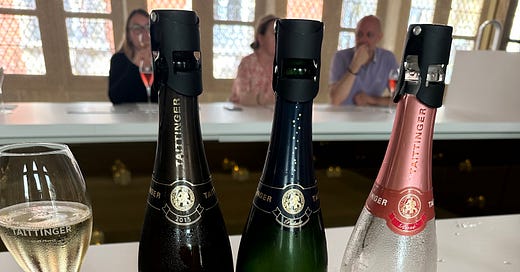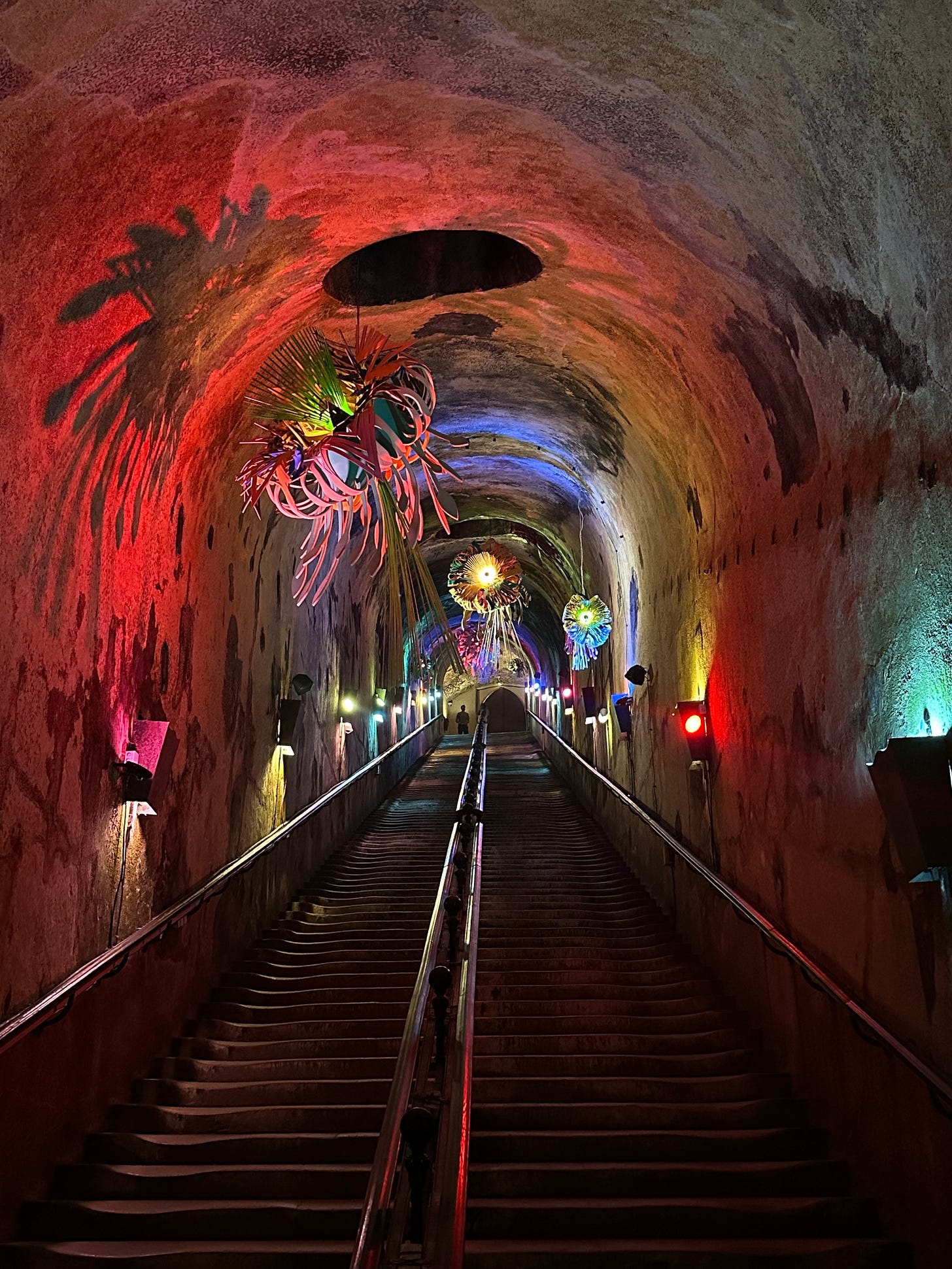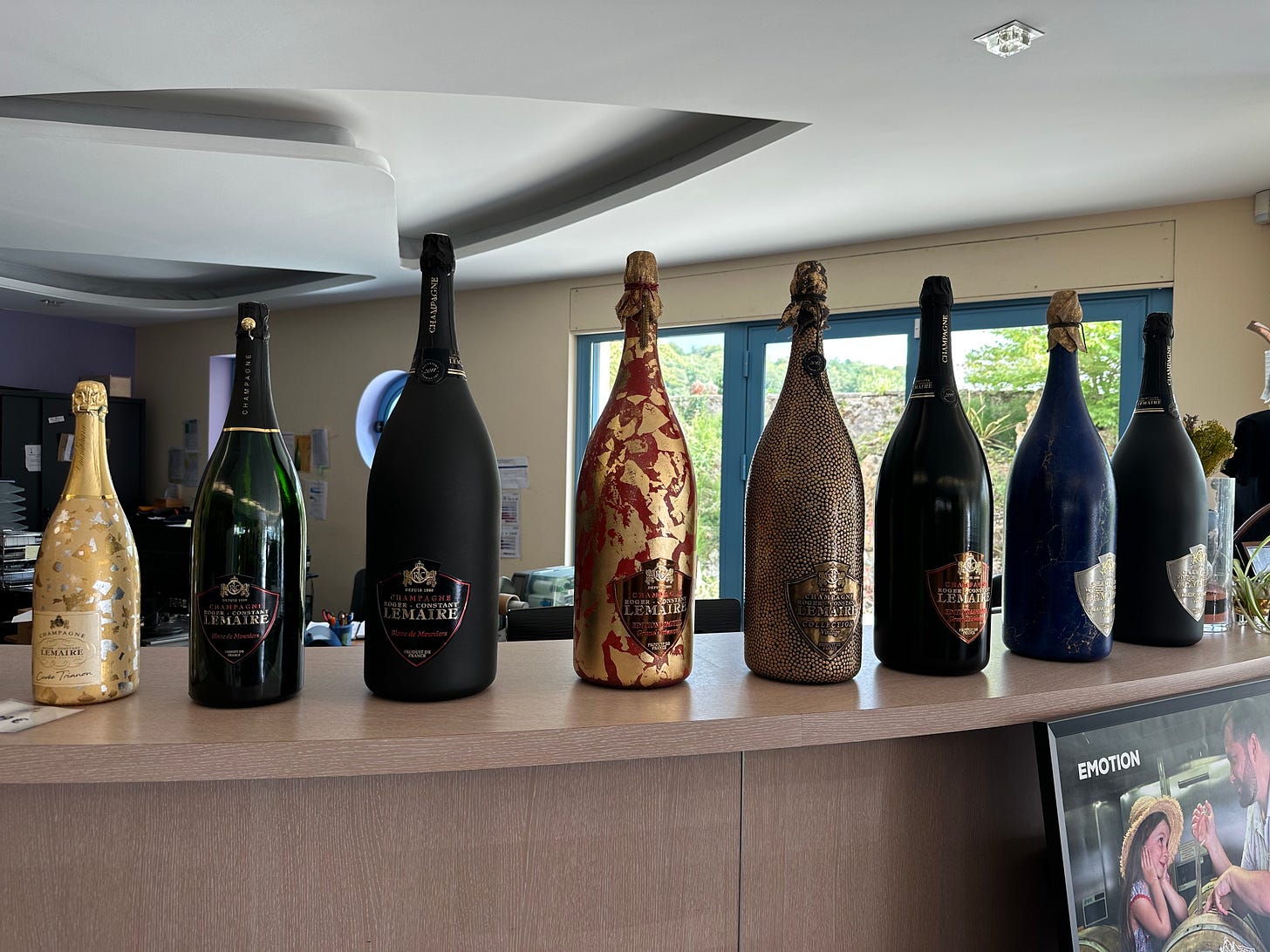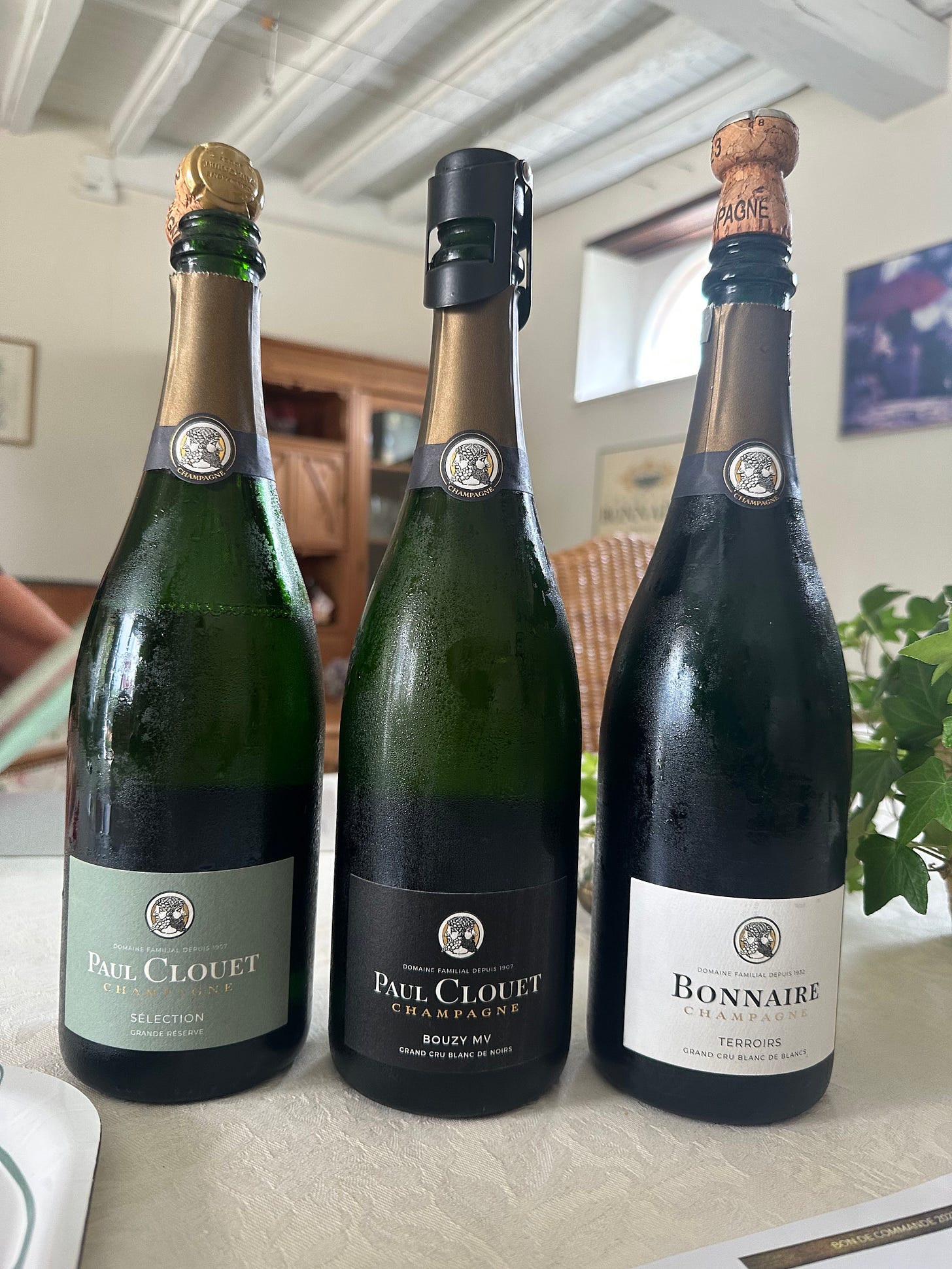Here in the U.S., Champagne is for celebrations. Customers at the store where I work are usually buying it as a gift or for a special occasion, because the pop of a cork signals festivity. In the last year, I can easily list the bottles I’ve purchased, because they are few - albeit probably more than the average person. Hey, it’s for professional purposes.
There’s one very practical reason we don’t reach for Champagne every day: it is expensive! The starting price point is around $40 per bottle, but $70-100 is much more typical and many bottles run into the multiple hundreds of dollars. Because of the base cost and the difficulty of preserving the freshness of sparkling wine, very few restaurants and wine bars offer Champagne by the glass; it’s much more common to find less expensive Cava, Prosecco, or American sparkling options on a by-the-glass menu. As a result, most of us don’t even have the opportunity to try different Champagnes and explore different styles and flavor profiles.
Thanks to some Delta flight credits that limitation recently changed for me, as I took a trip straight to the source: the Champagne region of France. Americans often use “Champagne” as a catch-all term for sparkling wine, but real Champagne has to come from this region, and it must be made following specific regulations. If you want an overview of sparkling wine, you can check out “All that Bubbles is Not Champagne.” All the grapes must be grown on designated plots within that region. Chardonnay, Pinot Noir, and Meunier are the primary grape varieties used in Champagne, although small amounts of Pinot blanc, Pinot gris, Arbane, and Petit Meslier are also allowed. Vineyard and winery practices are tightly controlled. All Champagne must be aged on the lees (the dead yeast cells left over after the second fermentation) at least eighteen months, and vintage Champagne at least three years. Unlike most wine, not all Champagne has a vintage year, as it’s typical in Champagne to blend multiple harvest years to maintain a consistent house style. Only in exceptional years do they declare a vintage and make a special release with its own distinctive profile.
Even working in wine, I have minimal opportunities to taste Champagne comparatively, so one of the huge benefits of actually being there is that there is Champagne everywhere. It’s a lifestyle there, not a special occasion drink. Even if you’re not touring Champagne houses all day (which I was, but maybe not everyone does that?), every restaurant has reasonably priced bottles and multiple glass pours. When you can get good Champagne for 10-15€ a glass, you can afford to try out a few different things and figure out what you like - and experience directly the fact that all Champagne is not created equal.
The first two houses I visited very quickly gave me a snapshot of the range of Champagne styles that might be available. Taittinger and Bollinger are both well known and respected houses, but their approaches are very different. Taittinger is located right in the heart of Reims, the largest city in Champagne. They blend the three major grape varieties, but emphasize the characteristics of the Chardonnay: lively acidity and bright fruit flavors. They use minimal oak to preserve fresh varietal characteristics, while the lees aging adds complexity without heaviness. The bubbles are delicate but very active in the mouth - like very sophisticated pop rocks. Taittinger is excellent aperitif Champagne and made me wish I had some oysters
.Bollinger is located in the village of Aÿ, about a half hour drive south of Reims. Their Champagne is also a blend of all three grape varieties, but they lean heavily toward the characteristics of Pinot Noir: fuller body and structure, and floral and red fruit aromas and flavors. Bollinger ages all of its wines in oak, which is quite rare, and the gradual oxidation adds aromatic complexity that can’t occur in wines aged in stainless steel, which is much more typical now. They also mature their Champagne in bottle for at least twice the amount of time required by law - often three and four times that amount of time. The bubbles are tiny, rich, and fill your entire mouth. Because I was there on an industry-specific visit, I had the rare opportunity to taste their entire range, and across the range, whether non-vintage or vintage, regular or rosé, the feel of Bollinger in the mouth is unforgettable: generous and expansive, with a finish that seems endless. I could imagine drinking it with nearly any meal, even something as heavy as steak, or just enjoying it on its own.
In a nutshell, Taittinger is a summer picnic capped off with a fireworks display; Bollinger is a slow and luxurious dinner with close friends.
I visited a number of other well-known Champagne houses: Pommery, Ayala, Mumm, Moët & Chandon (also the home of Dom Perignon), Mercier, Perrier-Jouët. They each have their own unique character that shows in the space and in the wine. Pommery is especially memorable, as its historic caves double as a museum of outlandish art, including a taxidermy elephant standing on its trunk. Why? I don’t know. It’s a weird place with mediocre Champagne, but worth the visit because it’s so odd.
FYI: Champagne is a rough place for people with accessibility issues. Most of the tours involve hundreds of stairs. Some do have elevator options if you make arrangements in advance.
On Monday morning I found myself in the garden at Moët & Chandon, sipping on Dom Perignon 2004 Plentitude 2. It’s easy for people who work in wine to poo-poo Dom as merely a status symbol, and yes, many people in the U.S. buy it for the name only. Before this trip I had tasted the 2010, 2012, and 2013 vintages, and my general take on them was that they were good, but I could get better for cheaper. That’s still true. All Dom Perignon is vintage, and the standard line is matured 7-10 years. Plenitude 2 comes from an exceptional vintage and is matured 15 years. It is stupid expensive (around $550 in the store where I work) and I would never buy a bottle, but I can now tell you that it really is a special wine. In some wines, you can just taste the quality of the fruit and the years of care, and as much as I hate to admit it, this is one of them.
As surreally wonderful as it was to be drinking nearly 20-year old Dom in a swanky garden, the real highlight of my trip was the visits I made to small vignerons - Champagne producers who grow their own fruit and make their own wine on site. What many of us may not realize about Champagne is that the major houses are not growing most of their own fruit. They purchase sometimes 90% of their juice from local growers. This isn’t necessarily a bad thing; it enables farmers who would never have the resources to make and sell Champagne on their own to earn a living from their land, reduces overhead for the houses so the cost per bottle isn’t even more elevated than it already is, and keeps all the land in the region from being snatched up by large corporations.
However, it also puts distance between the growing process and the winemaking process, and lessens quality control over the fruit. “Grower Champagne” as it’s come to be known ensures that the same people making the wine have overseen the entire growth, harvesting, and pressing process.
Because of the time of year - right at the end of summer holidays, and just before harvest - I wasn’t able to arrange many visits with smaller houses. The paid tour that also brought us to Pommery gave us an exercise in contrasts with a visit to Constant Lemaire, a much smaller and very casual house in Villers-Sous-Châtillon outside of Epernay. Don’t be fooled by the less lavish surroundings; their Champagne was world-class, and we got the personal touch of being able to chat with the winemaker. It was so good that I had a half case shipped home, and next time I’ll consider staying in their accommodations as well.
A dear friend who is living in Germany met up with me for a couple of days on this trip and, although I love traveling alone, it was great to have her company for the tour and kicking around for a while. We also visited Michel Gonet, a vigneron with a tasting room that offers a blind tasting game, which we failed miserably.
On my last day, I was alone again and a little tired of the big cave tours and tastings, so I drove out to some of the villages to see if I could find some of my favorite smaller Champagne houses, and perhaps someone would be there to show me around. Again, because of the time of year, this was mostly a fail, but I now know I can find Egly-Ouriet, Vilmart, and Marguet fairly easily in the future, and just getting to wander around the vineyards in Ambonnay and Bouzy was a treat. I do recommend wandering up to the doorways of the places that have open gates. If I had been there at a different time of year, I think I would have had more success, and at Marguet, although they didn’t have time to show me around, the person who answered the door was the winemaker himself, Benoit Marguet.
I wandered through one gate in Bouzy because they had a sign on the road suggesting they might actually be open for visitors, and although the woman spoke no English, and I speak no French, we managed to negotiate a tasting, and I came home with two excellent bottles of Grand Cru Champagne from Paul Clouet, which doesn’t even appear to have a website. My visit there was a bit awkward and confusing with the language gap, but it was also great, and we connected through “wine French,” which I understand by virtue of the fact that most wine words originate in French anyway. She managed to tell me a surprising amount about the terroir and winemaking process. You can (and should) drink Champagne anywhere, but these are the kinds of experiences that make traveling to the place worthwhile.
The downside is that you eventually have to come back to the U.S. and remember that Champagne is not readily and economically available to you at all times. Even so, the memories of Champagne as a whole and the wide range of aromas, flavors, and styles I experienced in the wines there will stick with me. I can’t just dart off to France as regularly as I’d like, but I definitely plan to go back with more intention, and at a better time of year when I can visit more of the smaller vignerons in a less awkward way.
In the meantime, I’ll be savoring what I brought back from Paul Clouet and waiting eagerly for my shipment from Constant Lemaire. I hope you also get some good Champagne in your glass soon, for a special occasion or an everyday celebration. Cheers!











Wow, what a great tour! Did you visit any recoltants? Aside from the main Champagne houses, I haven't heard of the smaller ones you mentioned, so I'm asking if any of them are Recoltants or not.
As for the language barrier, I totally agree and I really can't imagine how you were there most of the time by yourself without knowing French. I mean not only because you could get a better connection with the winemakers, but also to live anywhere outside the big tourist cities. But when I was in France, even in Paris, people mostly don't want to talk to me in English tho.